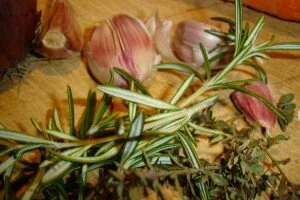
Slowly simmering soups on the woodburner has become a regular evening pastime in our house lately. Harira and Italian bean soup, my two latest concoctions are very rustic, hearty affairs – the sort of soups that verge on a stew, can make a satisfying meal and change each time I make them. It all depends what leftovers I have in the fridge, what veggies the pigeons and pheasants have left me in the garden and what sort of mood I’m in for extra spice or more robust herbs.
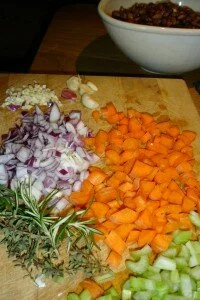
With cold, grey days and lots of germs and flu bugs still lingering (some brought home from school for half term) both soups have felt comforting and warming. Packed with veggies and pulses, and making use of leftover meat bones, they feel both frugal and healthy too. I hadn’t realised quite how nutritious both soups might be until I read Alex’s great piece on her Cold Comfort Soup in Dale cottage diaries however. Apparently, slow cooking of bones in stocks and soups helps release lots of health-giving minerals. Alex’s chicken soup looks wonderful too.
My harira, a Moroccan style soup with lots of lentils made an extra meal out of a cheap but excellent cut of lamb which had already provided us with two tasty stews. I’d visited Liz Knight of Forage Fine Foods at her lovely, remote hillside cottage on the borders of Herefordshire and Wales and enjoyed the simple but delicious stew she made with lamb that had grazed the wild, herb covered pastures around her home. Inspired by the flavour of the meat and by Liz’s homemade rose el hanout (made with dried rose petals) which was wonderful scattered on the lamb, I couldn’t resist buying some lamb from her local shop to take home.
Wanting to do justice to this very free-roaming lamb, we enjoyed lots of it in a simple stew with root veg (which provided 2 family meals) then added the bone and some leftovers to a Harira cooked slowly on the woodburner that evening. The Harira recipe is adapted from a recipe in Casa Moro by Samuel and Samantha Clark, one of my favourite cookery books. The flatbread recipes in here go wonderfully with this soup too. As I was vegetarian for years, I used to make variations of this with veggie stock (obviously without the lamb) and with a few more lentils and it was very tasty. But this is the version I made this week:
Harira
2.75 litres cold water
Leftover lamb/bones (I had neck of lamb leftovers)
2 tablespoons olive oil
1 onion, finely chopped
3 garlic cloves, finely chopped
1 red chilli, de-seeded and chopped
a pinch of dried chilli flakes
1/2 teaspoon each of ground cinnamon, turmeric and ginger, cumin and coriander (vary according to personal preference)
1 large bunch fresh coriander, stalks and leaves separated, washed and chopped
100g green or brown lentils
120g red lentils
1 400g tin of tomatoes
200g chard/spinach/kale/cavolo nero (depending what available/in season)
a squeeze of lemon
sea salt and black pepper
Heat the olive oil in a large saucepan, cook the onions slowly for 5 mins, then add garlic and spices and the coriander stalks, cook for another couple of minutes. Add the water and lamb, bring to simmer and cook slowly for 1/2 hour (if the lamb is raw, cook for another 1/2 hour). Add the lentils and simmer for another 1/2 hour. Add the tomatoes, cook for another 10 minutes then add the chopped chard and simmer for another 5 minutes. Season with salt, pepper, coriander leaves and lemon juice and continue to cook for another 10 minutes until the pulses are soft. Remove lamb bone, flaking off any meat into the soup, check seasoning and serve.
In between making the Harira and Italian Bean soup, I read some really interesting, thought provoking pieces about our consumption of meat. After the (surely not too surprising) recent discoveries of what some of the mass-produced processed meat products on sale actually contain, there are some really good points being made.
In her great post on ‘Meat Choices’ on her blog, Sally Prosser says:
” The industrialisation of farming in agriculture and animals (including the failed promises and potential catastrophe of GM crops) and the pervasive spread of increasingly processed foods in the hands of fewer and more powerful corporations and retailers is one of the most sinister threats of our age. So what can we do?”
In my opinion, one of the things that we can do, is go back to using well-reared meat sparingly, something that to pre-war generations was a way of life. Cheap cuts of well-reared meat can be easily (and deliciously) padded out with pulses to make so many tasty, healthy and frugal meals. And I agree with Trine Hahnemann’s ideas in The Nordic Diet about eating wild or free-range meat a couple of times a week then eating several fish and veggie meals. Surely this is good for our health as well as our environment?
Alex Stevenson in her Notes on a Scandal piece on her blog, says:
“To me, and many other smallholders, food is the key reason for taking up such a lifestyle, to know what we are eating, what’s in it and how it is produced. This is an aspect of food consumption which as a society, we are getting further and further away from.”
Similarly, I know that I’m lucky to live in a rural area where it’s easy to buy good meat – and to have raised our own rare breed pigs last year. I feel fortunate to have the space to enjoy growing veggies too. And I know that our society has complex problems to resolve associated with food production, to which there aren’t easy answers.


Making soup may not be the answer to all our meat issues, but slow cooking a handful of beans or pulses with vegetables and good stock is a satisfying activity for a cold February evening! I had a ham bone in the freezer from a home-cured joint I cooked last time my family came to visit. This is the Italian peasant style soup I made from it. It makes enough for several suppers.
Italian Bean Soup
450g dried borlotti beans (you could use 2 tins of cannellini or borlotti beans instead) soaked overnight, then boiled for 15 mins and washed
7 tablespoons extra virgin olive oil
5 garlic cloves
2 onions, finely chopped
2 carrots, finely chopped
1 leek, chopped
2 sticks celery, finely chopped
1/2 tin tomatoes
1 ham bone (if you don’t have a ham bone, I’ve made a veggie version with leftover parnesan rinds added for extra savoury flavour)
1.5 litres water
300g cabbage leaves (cavolo nero is perfect, but I used January King cabbage this time)
1 sprig rosemary and a few sprigs of thyme
slices of bread to serve, ideally sourdough or ciabatta style
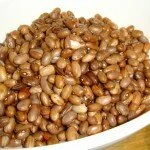
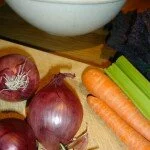
Heat 3 tablespoons oil, chop two of garlic cloves and cook with onions and leeks slowly for 5 minutes, without colouring. Add the remaining vegetables, sweat for a few minutes then add the ham bone, beans and water. Cover, bring to boil and simmer for about 1 hour until beans are tender. Remove the ham bone and puree some of the soup with a handheld blender. I like some texture, so remove half the beans/veg and puree what’s left in the pan – but you can liquidise more if you want a thick soup. Add beans/veg back to liquidised soup along with cabbage and simmer gently 10 minutes until cabbage tender.
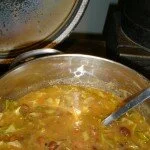
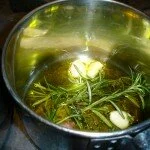
While the cabbage is cooking, pour remaining oil into a small saucepan and heat it gently with the rosemary, thyme and 2 of the remaining garlic cloves (brusised but unpeeled). After about 10 minutes, strain the now flavoured oil into the soup and heat it through for a few minutes, stirring and season with salt and pepper to taste. Toast bread and rub with remaining garlic clove, placing in the bottom of soup bowl before ladling over the soup – it will soak up all the lovely flavours. Great with parmesan too.
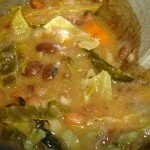

The soup will keep well for a few days in the fridge, in fact its flavour improves the day after it’s made.
And sorry, we ate all the harira before I remembered that I hadn’t taken any pics!


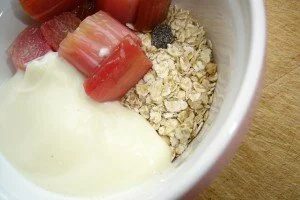
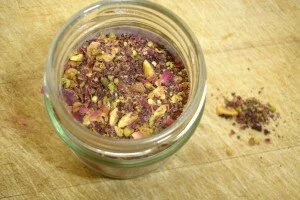
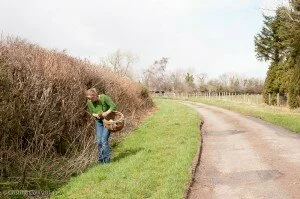

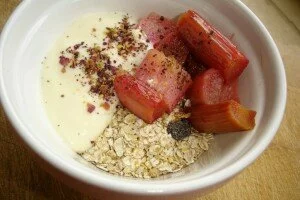
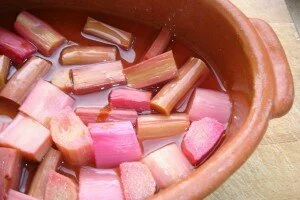
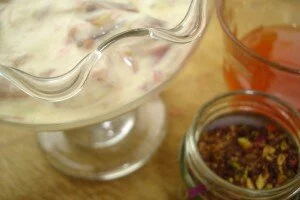
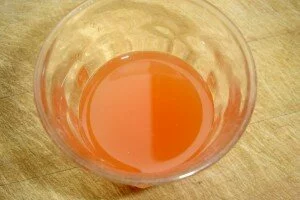
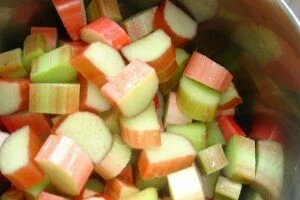

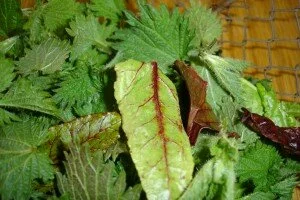


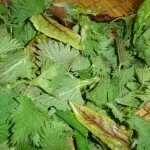
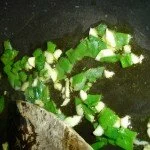
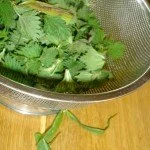
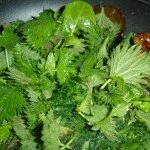
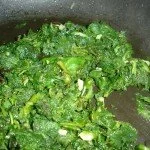




 When I visited Liz Knight at her cottage in the hills near Abergavenny, I was immediately tempted by the smell of chocolate and chestnut cake baking. Then I noticed the preserving pan of haw berry ketchup on the hob and couldn’t help being drawn to the russet jars of amber coloured medlar and heather jelly and the bottles of rose syrup. It was a grey, bitterly cold morning and on my drive up the hill it seemed as if Spring had yet to arrive. Yet as Liz poured us coffee she talked about the abundance of salad ingredients outside her door; mustard flavoured chickweed, wood sorrel or pennywort to add crunch and texture. Pennywort grows in cracks in walls and is excellent in a green sauce too.
When I visited Liz Knight at her cottage in the hills near Abergavenny, I was immediately tempted by the smell of chocolate and chestnut cake baking. Then I noticed the preserving pan of haw berry ketchup on the hob and couldn’t help being drawn to the russet jars of amber coloured medlar and heather jelly and the bottles of rose syrup. It was a grey, bitterly cold morning and on my drive up the hill it seemed as if Spring had yet to arrive. Yet as Liz poured us coffee she talked about the abundance of salad ingredients outside her door; mustard flavoured chickweed, wood sorrel or pennywort to add crunch and texture. Pennywort grows in cracks in walls and is excellent in a green sauce too.










